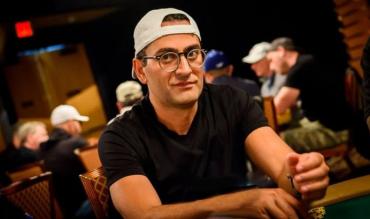Peanut butter and jelly, Bonnie and Clyde, beer, and hangovers - some things just go together.
Take sports, for example: Football has Mbappe, chess has Carlsen, and water polo, Zoltán Szécsi… apparently. Thanks, Google!
Poker has its own superstars, too - legends like Doyle Brunson, Scotty Nguyen, and Johnny Chan, top plenty of favourite player lists. So do new-school crushers like Fedor Holtz and Patrick Leonard.
Many withstand the test of time born out of impressive performances at the tables. Players like Daniel Negreanu and Phill Hellmuth have thrived against the poker elite for decades. Some heroes like Phil Laak or Tony G have high charisma and intriguing personalities.
Antonio Esfandiari is one of those names.
He has banked almost $28,000,000 at the tables (according to thehendonmob.com). Esfandiari has also built an impressive resume as a successful commentator, entertainer, and crazy prop-bettor.
Why So Serious?
Esfandiari is an unquestionably talented poker player. But the source of his popularity is his personality, which brings a little mischief to the tables.
Anyone watching TV shows like High Stakes Poker and Poker After Dark would have found Antonio’s persona unlike anything else. Amplified via interactions with his good friend and fellow tyke, Phil Laak, Antonio was playfully risqué throughout.
His banter style was an instant breath of fresh air in a poker industry that seems to be increasingly taking itself way too seriously. Watching him tilt Hellmuth into infamous meltdowns, shower Dwan with backhanded compliments, and persuade businessmen to do outlandish push-up challenges was a hoot!
And even if you hated it, it’s hard to deny the entertainment value.
Check out his exploits on past and current seasons of High Stakes Poker and his own TV series, ‘I Bet You’. Esfandiari's mischievous nature does far more for the game of poker than the emotionless robots hidden behind sunglasses and hoodies at today's feature tables.
That said, it takes unbelievable discipline, focus and skill to perform at the levels they do. But while they might be playing excellent poker, they don’t tend to be the most exciting watch, do they?
Most new players see poker as a fun social activity with their friends. Just like playing 5-aside football or gorging at an all-you-can-eat buffet, they're in it for the buzz:
To scoop big pots and laugh at their friends as they wave a random bluff in their faces.
They probably hope to make a few bucks along the way. But that’s as far as most people’s poker aspirations go.
Putting the Fun back into Poker

For the casual player, it’s about fun, not world dominance. Recreational players are there to enjoy themselves. Weird kinks aside, the prospect of an 8-minute stare-down from a guy in an improvised ski mask just isn't that appealing.
Many experienced players seem to forget this fact. They’re too focused on winning, and this makes them seem intimidating. Poker is a relatively selfish game. But ensuring amateur players enjoy their time at the tables is vital for the game. It keeps them playing.
Along with his pal Phil Laak, Esfandiari understands the entertainment factor. In an interview. He discussed the origins of their homemade game, ‘Lodden Thinks’ (which we’ll explain later).
Phil Laak described how the game was born. Misquoting the famous proverb, "Necessity is the mother of invention," Laak explains how he and Esfandiari had a conversation about the need to ‘come up with new material’ before a stint on a feature table.
You can watch the interview below:
So why is this? Why do players like Laak and Esfandiari care about the audience so much?
- They aren’t playing the tournaments?
- They aren’t losing money?
- They aren’t paying rake, right?
The Need for Excitement!
Well, let’s be honest. There’s probably a little ego involved, for a start. Like many public figures, Laak and Esfandiari seem to enjoy the limelight. But there’s a larger force at work too.
The sad reality is that watching poker can be pretty dull, especially on a feature table where things often get quite tense. Boring games are unlikely to appeal to the poker newbies within the audience,. They may have tuned in out of curiosity or to support a friend or family member playing in the line-up.
As a result, feature tables are an excellent opportunity to expose potential players to the world of poker, especially if the stream is on mainstream TV.

Most players overlook the value in this publicity for the game. It’s clear from their comments that Laak and Esfandiari understand the power of showcasing fun and exciting poker games. They realise that boring feature tables are unlikely to drive potential new players to the tables.
The game gets smaller and toughener without new blood until it is strangled to death.
Why Entertain Poker Players?
Well, it’s pretty straightforward. While there will be some fresh blood, most of a stream’s audience will consist of active poker players. These poker streams are a terrific way of encouraging these dormant players to hop into a game. Live streams give them a taste of the action.
They see vast sums of money changing hands and get itchy fingers. A little FOMO later, they’re ten tables deep into a session. The more this happens, the more cash is pumped into the poker ecosystem and the healthier it becomes.
This situation is great for everyone: The poker site, the poker economy and, ultimately, the players.
The casual $10 or $50 deposit might not seem essential to high-stakes players like Laak and Esfandiari. But these micro-deposits are what keep the poker economy turning. Eventually, the array of micro deposits adds up to a sizeable chunk. The money moves up through the stakes and, ultimately, to professional players like them.
In a more immediate sense, by promoting poker as fun, Laak and Esfandiari make their higher-stakes games more attractive.
In a hand where Esfandiari shows the table that he is slow-rolling Phil Laak’s Q9 with kings, the tension is instantly released by the joke.
At showdown, Esfandiari’s comments, ‘nice ship Phill,’ and, ‘Phill Laak, ladies and gentlemen!’ These words turn what would otherwise be a gloomy and dull hand into fun and laughter.
You might think a slow-roll is out of line, and to anyone else, this would be pretty disrespectful, but as his good friend, Laak knows the drill.
Their relationship is all part of the show, and Phill plays along, returning fire after the 3d9cTsAa9d runout.
It’s essential to note that Antonio is involved in many of these confrontations with other regs. But he is far more gracious and respectful to the recreational players at the tables.
In another hand, Antonio is coolered by Guy Laliberté in a flush-on-flush confrontation. He simply smiles and says, ‘Nice hand. I got greedy.’ It’s the opposite of what you see at many live tables. And it’s very methodical.
By ridiculing regs such as Hellmuth, Dwan and Jungleman, Esfandiari makes them seem less scary. High-stakes games seem far less intimidating, coupled with his sense of humour and respect for amateurs,

Whether intentional or not, Esfandiari is a great poker ambassador. People smile when they see him giving an energetic interview or orchestrating some ludicrous contest.
He may come across as outlandish and even a little insubordinate. But his mischievous antics help to promote a fun, banter-filled poker experience.
Lodden Thinks
Lodden Thinks is a strategic quiz in which two players bet on a third person’s answer to a question. Antonio and Laak invented the game during their time at a WSOPE feature table. They wanted a way to make things more entertaining.
Johnny Lodden was the first ever ‘Brain’ and the game’s original namesake.
Players are betting on a third person’s opinion (known as ‘The Brain’ or ‘Lodden Thinker’). So, the truthful answer to the question is irrelevant. But a qualifying question must have a numerical answer.
The winner is the player whose answer is closest to The Brain’s.
Here’s a highlight reel of Antonio, and Lodden Thinks, in action:
The most strategic (and fun) part of the Lodden Thinks comes during the auction stage of the game. This bidding round starts with one player making an opening offer. These proposed bets are typically very conservative. A bid in Lodden Thinks is not a specific number but a range of numbers that includes everything above the bid.
A bid of “10” would be a bet of “10 or more”, for example. So, an opening offer should be way lower than what you believe The Brain’s answer will be.
| Say the question is, “How many dogs does The Brain think Lady Gaga has touched this year?” A player might make an opening offer of “5 and over”, even if they believe the answer to be closer to 20. |
They can make a counterbid if their opponent thinks this bid is too low (and The Brain’s answer will be higher than 5). The first player can accept the new proposal or make a higher one themselves.
This process repeats until the players have an agreement.
Esfandiari likened this to a Chinese Auction where entrants buy multiple raffle tickets to increase their chances of winning.
The aim is to get the lowest number you think will be a correct answer to maximise your chances of winning. You can also attempt to trick your opponent into bidding too high.
In the Lady Gaga example above, the betting round might resemble something like this:
- Player 1: “How many dogs does The Brain think Lady Gaga has touched this year?”
- Player 2 (Who believes The Brain’s answer will be around 20): “Over 5 dogs.”
- Player 1: “Over 6 dogs.”
- Player 2: “Over 10 dogs.”
- Player 1: “Over 25 dogs.”
- Player 2: “Sold.”
In this case, Player 2 now has numbers 0-24. He would win if The Brain’s answer were 24 or less, and Player 1 would win if The Brain’s answer were 25 or higher.
According to Phil Laak, Lodden Thinks can be played by anyone, so long as ‘they are not in a coma.’
Here’s a summary of how to do so.
- Players nominate someone to be the Brain.
- One of the other two players asks the other a question with a numerical answer.
- The Brain gets some time to consider their answer and, if possible, writes it down or tells it to someone else. This process ensures that there is no cheating.
- Players bid on their answers until they agree on a clear ‘over and under’ number.
- The Brain reveals their answer, and the winner takes home bragging rights!
As well as killing time at the tables, Lodden Thinks is a great way to liven up a long drive or a house party. game
Your imagination only limits the absurdity of the questions. So, there is a lot of fun to be had by all!
Lodden Thinks is probably one of Esfandiari’s best legacies and a fantastic example of how he tried to make the tables as fun as possible.


